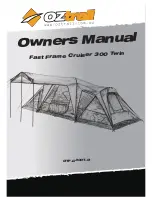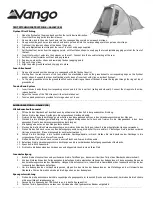
4
Step 1 Choose the Site
Select a sheltered camp site protected from the
wind that will not allow water to pond under
the tent floor. Clear a level area of all stones,
twigs, etc. Always look up to ensure you are not
camping under dead branches or Eucalypt trees
if possible. We also recommend using some
form of ground protection to protect the floor
of your tent – if you are using one; lay it out on
your site first.
Step 2 Lay out the tent
Unpack the contents of your tent. Release and
remove the webbing straps around the packed
tent. Carefully unfold and lay out the inner
of your tent ensuring that you have the door
facing in the direction you require.
Step 3 Peg down one corner
of the tent
It can be helpful to peg one corner of your tent
to protect it from being blown around by wind.
If there is wind about, you may want to consider
pegging all four corners for safety.
Step 4 Extend the
telescoping legs
Select the first leg to extend. Before extending
the poles ensure they are aligned correctly with
the centre hub, and are not twisted. Telescope
the pole sections apart until the metal locking
pin clicks into place. The first leg will be tougher
to extend, this is due to the tents internal
tensioning system. Extend the remaining legs
one at a time – the tent will now stand (Figure 1).
Step 5 Insert supporting
side room section poles
Locate the fibreglass support poles and
assemble so they form two pieces. Insert poles
into the pole sleeves on the exterior of the inner
tent, placing each end of the fibreglass poles
into the housing of the plastic hub. Next select
the steel support pole and place one end into
the corresponding plastic housing of the hub.
The other end of the steel pole should attach to
the ring and pin at the tent base as displayed in
Figure 2. Repeat this step for remaining three
support poles.
Assembly Instructions
HELPFUL HINT
Avoid pinch points when opening or closing the
tent frame. Be careful not to twist or force the
frame assembly when unfolding the tent.
Figure 1
Figure 2


































